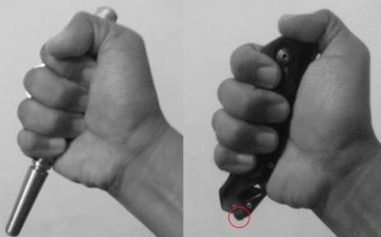The palm stick is known by many names among Filipino martial arts (FMA) practitioners. Among the more popular terms for this weapon are tabak maliit (small sword), olisi palad (palm stick) and dulo-dulo (one end to the other).
The most common material for making palm sticks is hardwood though versions made of steel or hard plastic are also available. There are even a few traditional escrimadors who use deer antlers (sungay ng usa) as palm stick.
While there are FMA styles that offer extensive curriculum on the use of the palm stick, a knowledgeable escrimador knows that it is just another weapon. If he understands the essence of the FMA, he knows he can pick up any handheld weapon regardless of shape and size and use it effectively, to quote Dan Inosanto, “When you get to the root of a technique, it doesn’t matter what the hand is holding.”
The most obvious benefit of training with the palm stick is that it is a weapon that is easy to conceal. And even if you don’t carry a palm stick, some common objects can be used as a substitute like a thick pen, an eyeglass case or other sturdy objects of similar shape.
Folding knives like the balisong or the modern tactical folder can be deployed in a less lethal manner by using them closed as a palm stick. Some tactical folders are built with a glass breaker making them ideal bludgeoning implements. In the case of the balisong, it is better to use the exposed tang of the closed blade for hitting than the other end of the handle where the latch is located because the latter is more susceptible to damage.
Another benefit of palm stick training is that after the dagger, it is the shortest weapon that an FMA student can learn to understand the transition between weapons and empty hand fighting. Take note that the FMA being originally a battlefield art has a reversed progression of training compared to other Asian martial arts.
In arnis, escrima and kali, the student trains with weapons first then later on progress to empty hand fighting. A quote from the late escrima master John LaCoste in Inosanto’s book The Filipino Martial Arts reads, “If you want to learn how to use your fist – you must first learn how to use the weapon.” As a student progresses in FMA training, he would realize that by shortening the weapon, all the techniques would work just as well in empty hand combat.
The palm stick is primarily an impact weapon that can be employed using hammering, hooking or jabbing motions. To me, the most damaging way to use the palm stick is via trap and hit technique meaning you immobilize the opponent’s hand with some kind of hold or lock so you can pummel on his skull with impunity. In a grappling situation, you can use the palm stick to pinch on flesh or to dig on nerve-rich areas.
All the basic angles of attack employed in stick and dagger training are applicable to palm stick practice. From that, the student can progress to basic limb destruction drills with a partner before proceeding to specific self-defense techniques and eventually free sparring.
While the angles of attacks remain constant in arnis, escrima, kali training, the student must realize that there are subtle differences when transitioning from weapons to empty hand combat.
A change in reach will obviously affect how you close the gap and score a hit on your opponent. A weapon with a shorter reach also means more danger to the user. Using a palm stick therefore requires more skilful footwork before you can close in and inflict damage on your foe.
A student must also realize that a palm stick cannot compete with a regular fighting stick or a dagger in terms of stopping power. It simply lacks the weight and mass of a hardwood garote or the sharp edge of a knife hence the wielder of a palm stick must generate greater striking force and must carefully select his target to inflict a disabling injury.
The palm stick is used in close range so the necessary attributes for fighting in that kind of distance must be likewise developed. Besides hand speed, arm strength and body placement, a crucial attribute in using the palm stick is kinesthetic sensitivity. The latter is the ability to read the energy of one’s opponent through touch. Tapi-tapi and other close quarter drills where you are taught to detect pressure or lack of pressure in your partner’s limbs are good ways of developing kinesthetic sensitivity.
You need kinesthetic sensitivity when fighting close range because in that environment you cannot depend much on your sight to detect strikes from your foe. When you are in clinch or trapping range, your defense would most likely depend on your kinesthetic sense.





















